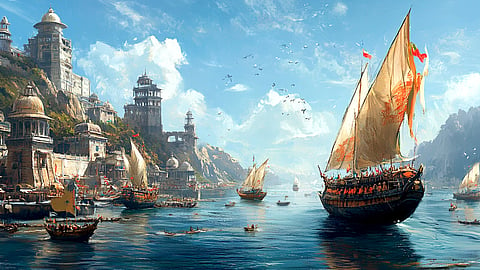- Commentary
- History Vignettes
- Notes on Culture
- Dispatches
- Podcasts
- Indian LanguagesIndian Languages
- Support

NOW, WE CAN LOOK at a few examples that show the innate nobility, magnanimity and compassion embedded in the character of a typical Saarthavaha.
A well-organized Saartha typically moved on a highway (Ghantapatha). It broke the journey at midday for lunch. The Saarthavaha took care to guide the caravan’s journey as close to villages and grazing grounds as possible. At dusk, he pitched the camp at places where Sanyasins could easily obtain Bhiksha.
As we have already seen, depending on its size, the operations of a Saartha could be confined to just a few states or they could be pan-Indian or transnational. The smaller caravans in some cases would wait at a place for several days or weeks to join larger caravans. This was typically the case when these smaller caravans anticipated danger. In other cases, these smaller caravans entered into business agreements similar to the joint venture projects in contemporary business parlance.
And now, we present a brief picture of the extent, impact and role of Saarthas on the national canvas of ancient Bharatavarsha. From the outline of the commercial geography of ancient India that we described earlier, it is clear that Saarthas were not restricted to land alone but operated on waters as well.
In this connection, scholars often refer to Dashakumaracharita composed by the gifted sixth Century Sanskrit poet and scholar, Dandi who flourished in Kanchipuram. This Sanskrit work gives us clear evidence of our maritime trade links with Iran and Iraq. The sixth chapter is particularly interesting. It tells the story of a certain Mitragupta who was thrown into the sea at the Tamralipti port by royal order. The next morning, a Yavana ship rescued him from drowning. The rescuers took him to their captain Rameshu who was happy to recruit a strong slave who would help him irrigate his vineyard. In the meanwhile, a battleship (madgu) surrounded by many boats attacked this Yavana ship. Hopelessly outnumbered, the Yavanas began losing the battle. At that moment, Mitragupta requested Rameshu to remove his chains. Then, he counter attacked and defeated the enemy.
In fact, there is extensive maritime technical terminology that provides conclusive evidence for the thriving activities of these water-oriented Saarthas.
Saartha members who travelled together on ships were known as Sāmyātrikas. The Jalaniryaamaka was the captain of the maritime caravan who guided its route, and had a thorough knowledge of the sixteen types of winds.
People wishing for employment in maritime caravans had to compulsorily undergo a rigorous training course in the niryamaka sutra or nautical science. We have evidence for the existence of such a training college in the port of Supparaka, which has now become an overcrowded and dirty Mumbai suburb known as Sopara.
In fact, the most glaring evidence for maritime Saartha activity lies in the names of just two Buddhist deities: Manimekhala, the guardian Goddess of the Seas, worshipped for centuries in South India; and the Yaksha Manibhadra, the presiding deity of sea-merchants of North India. In fact, the Jataka story, Samudra Vanija Jataka leaves no room for doubt in this regard.
And then we have the little-explored, glorious chapter of the maritime history of the Gupta Empire which derived substantial revenue from these sea-faring caravans. Literary and other evidence repeatedly mention that a big indicator of a wealthy person was the fact that he was engaged in the shipping business and maritime trade. Nobody can match the splendor of Acharya Vasudeva Sharan Agarwal who eloquently describes the Gupta maritime prowess and opulence.
In the Gupta period when the great sea traders returned after earning much gold and precious stones then they distributed a part of their earnings in charity. Among the sixteen great alms of the Matsya Parana is included the sapta-samudra mahadana, the water of the wells from the sankalpa was taken from the seven seas. The figure of Sri Lakshmi standing on a boat depicted on a Gupta period seal…symbolised the gainful contemporary sea trade.
Indeed, what is a better indicator of our glorious maritime culture than Sri Lakshmi herself, born out of the Ksheerasagara? Small wonder that she is extolled in the famous Sri Suktam as Lakshmim Ksheerasamudraraja tanayaam, etc.
In fact, there is much meaning in the very name of the greatest Gupta Emperor, who is unambiguously named Samudra Gupta.
Finally, Sri Agarwal concludes this account with words etched in gold:
It is difficult to understand the story of Indian history without understanding the great achievements of Indian sailors and sea captains and their close cooperation with caravan leaders…A determined and dutiful sailor always thought, “I am a servant who works on the ship for wages. It is due to this ship that I earn my livelihood. I should never be idle and neglectful in my duties. I should always be busy in my work attentively.” This thought was the true foundation of the ancient Indian shipping. The Indian caravan always extended an earnest invitation to people to come out of the safety of their houses and lead a healthy outdoor life. Travelling with a caravan was never burdensome for an individual as it was accompanied by happiness, courage, comradeship and helpfulness.
In just a few pithy lines, Sri Agarwal has given us a range of timeless values such as an ideal work ethic, a sense of duty, a profound inspiration, a call for Karma, and a zest for life.
He has also given us perhaps the best assessment of the ancient Indian economic engine called Saartha.
To be continued
The Dharma Dispatch is now available on Telegram! For original and insightful narratives on Indian Culture and History, subscribe to us on Telegram.
